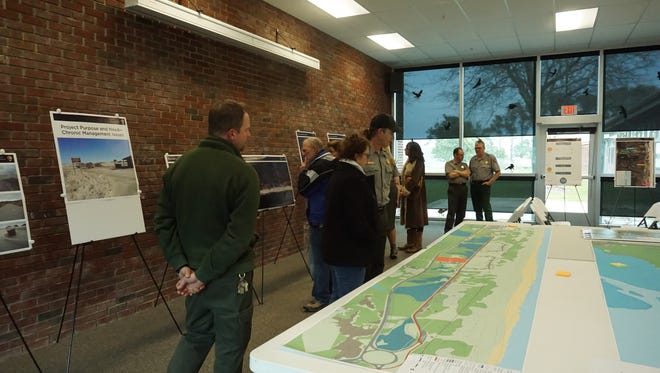Assateague National Seashore confronts mounting threats

With evidence of a mounting risk to campsites on the Assateague Island National Seashore, the park presented its plans to move crucial infrastructure westward.
At a public event Thursday, March 30, members of the community met with park rangers and administration to learn about out the need for planning and action.
Lined wall to wall were projections of past data, as well as predicted data for the course of landscape change on the Island. Specifically, certain parts of the coastline moved about 100 feet to the west between 1996 and 2015. According to studies done by the park, those portions could move 250 feet farther west by 2040. The projections also place a secondary dune aligned right with the eastern tip of the parking lot at Bayberry Drive.
"This is something we want to do incrementally," said Deborah Darden, park superintendent. "What we need to do first is address the places that are most at risk, and then gradually work our way through the rest of the campsites."
The funding for the project will be provided entirely from the park's fee rates for visitors.
BACKGROUND: Caretakers seek to counter sea swamping Assateague
The impact of 2016's Winter Storm Jonah, Darden said, exemplified an area extremely vulnerable to storm damage, placing some campsites underwater temporarily. While barrier islands, by nature, have dynamic landscapes shaped by the ebb and flow of the sea, Darden said what's occurred over the past few decades is outside the norm.
"Back in the 80s, it took a major storm to do something like this," Darden said. "Now, we're starting to see the same things happening with minor storm events, and on a much more regular basis."
At the current rate, Darden said about 5 feet of beach is lost each year. According to the park's general management plan, the sea around Assateague is expected to rise between 3.5 to 9 inches by 2040.
The campsite movements are not part of the general management plan, which hopes to prepare for and combat the impact of climate change and sea level rise. However, Liz Clarke, a contractor who assisted in drafting the plan, said the project works in the same spirit as the plan.
"We had a lot of options at first," Clarke said. "One was just to simply do nothing, and another was to build an actual, barrier wall to protect the campsites. This option, we think, is the best one for keeping the park sustainable for as long as possible, and still have a place for campers."

For Assateague Coastkeeper Kathy Phillips, the project is a step in the right direction.
"What the National Park Service is doing is preparing, and that's a good thing," Phillips said. "This is going to keep happening, whether they do something or not, and the fact that they're not only acting, but giving citizens a chance to voice their concerns or comments."
Primarily, Phillips lauded the park for its awareness of its future should they not act.
"What this shows is the National Park Service is cognizant of these really special, primitive areas," Phillips said.
READ MORE: Assateague State Park to cut 8 campsites
Browsing over the photos and maps on display, Worcester County Commissioner Bud Church, who represents the district Assateague falls in, said he believes the park is doing the right thing.
"I'm still learning, I don't know all of the science on this," Church said. "But when you look at these areas that seem to be always at risk for flooding, there seems to really be a need to do something."
While the plan is in its infancy, a full document detailing the goals and methodology for the project is expected to come by the end of summer, with a goal to have the wheels in motion by the end of the year.
"People are right to say that barrier islands are constantly changing," Darden said. "But what we're experiencing is different from anything we've seen before, and we decided something has to be done."